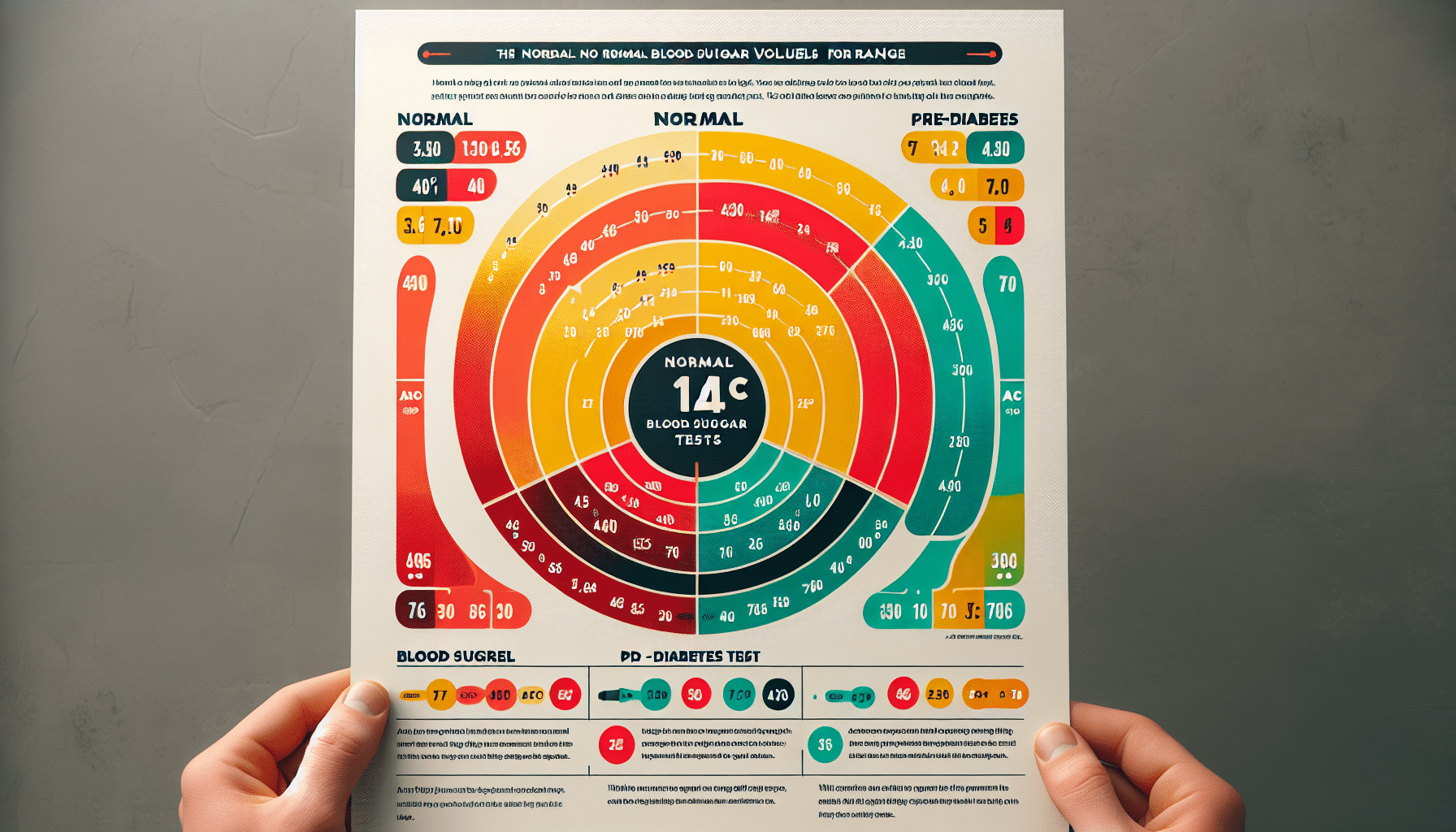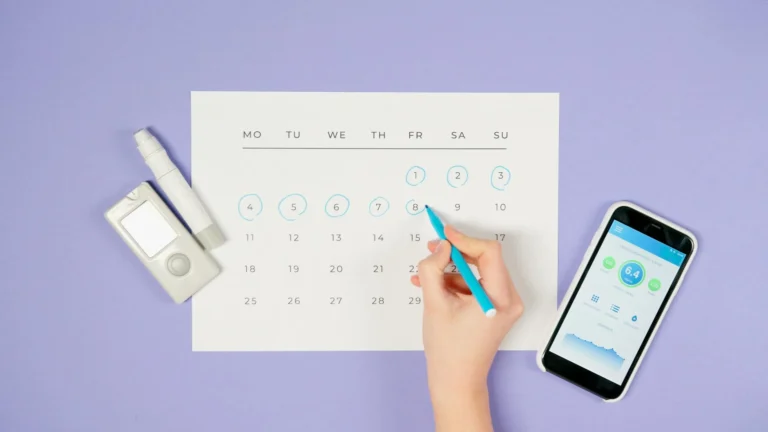Normal A1C Values: Empower Your Diabetes Health
Discover normal A1C values and tips for managing your levels. Empower your health with friendly advice and easy strategies!
If you’re dealing with diabetes, it’s pretty important to get the hang of your A1C levels. So, let’s break it down for ya.
What is the A1C Test?
The A1C test is like your report card for blood sugar over the last three months. It’s sometimes called the hemoglobin A1C, HbA1c, or glycohemoglobin test. Basically, it tells you how much sugar’s been hanging out with your red blood cells.
Hemoglobin, found in red blood cells, acts like an oxygen taxi. When sugar enters your bloodstream, it hitches a ride on hemoglobin—you know, like a sugar barnacle. The higher your A1C number, the more sugar barnacles you’ve got, meaning sweet levels have been riding high over the last three months.
| A1C Level (%) | Estimated Average Glucose (mg/dL) |
|---|---|
| 5 | 97 |
| 6 | 126 |
| 7 | 154 |
| 8 | 183 |
| 9 | 212 |
| 10 | 240 |
Feeling curious? Check out our a1c calculator tool and A1C calculator guide for more details.
Importance of A1C Testing
Testing for A1C is like your secret weapon in the battle against diabetes. It’s crucial for diagnosing the big D, keeping tabs on diabetes, and seeing how treatment is panning out. Trust me, it’s a big deal.
- Diagnosis: If your A1C’s sneaking upwards, it might be a red flag for diabetes or a warning that you’re heading that way.
- Monitoring: Regular A1C checks are like having a window into how your game plan’s doing. It’s a reality check to see if things are on track.
- Predicting Risk: A high five to you if you keep those A1C levels low. If not, it’s like inviting trouble with heart, kidney, and even nerve problems.
For a quick look at what normal A1C values are and where to aim, head over to our a1c reference range.
Getting to grips with A1C means you’re steering your diabetes with some swagger. Curious about dropping those A1C levels? Hop on over to our guide on reducing a1c naturally for some nifty tips.
Interpreting Your A1C Test Results
Getting a grip on your A1C test results is like holding the keys to your own health ride, especially when it comes to managing those tricky blood sugar levels. Let’s decode what those percentages on your report card really say, whether you’re dealing with diabetes or you’re not.
Normal A1C Values
If you don’t have diabetes, your A1C score can pretty much tell you where you stand with your blood sugar. The folks over at the Cleveland Clinic mention that normal A1C values are under 5.7% (the sweet spot). Here’s how to read your results:
| A1C Level (%) | What It Means |
|---|---|
| Below 5.7 | You’re in great shape! |
| 5.7 – 6.4 | Prediabetes might be knocking |
| 6.5 or higher | Diabetes is calling |
Hitting anywhere between 5.7% and 6.4% is like a nudge saying, “Hey, you might be on your way to diabetes.” Beyond 6.5%? That’s the diabetes zone (WebMD).
Curious to dive deeper? Check our a1c reference range.
A1C Value Goals for People with Diabetes
Once diabetes is part of your life story, those A1C numbers become the main characters. The American Diabetes Association says most adults should aim for an A1C of 7% or less (Cleveland Clinic). Here’s how to keep score:
| A1C Level (%) | How You’re Doing | What to Do Next |
|---|---|---|
| Below 7 | You’re on track! | Keep up whatever it is you’re doing! |
| 7 – 8 | Needs work | Maybe chat with your doc about tweaking things |
| Above 9 | Red Alert | Don’t wait to act. Your health needs a makeover |
These A1C values aren’t one-size-fits-all. Age, health vibes, and other stuff matter too. So, it’s smart to team up with your healthcare provider for the best A1C game plan (Healthline).
According to Verywell Health, running over a 9% A1C is like flirting with trouble — think diabetes-related problems. Keeping it lower is all about dodging those life-long complications.
To find out how you can naturally bring those numbers down, swing by our tips on how to reduce A1C naturally.
With these numbers under your belt, you guys can steer the diabetes wheel better and cut some corners to keep blood sugar in check. Looking for a personal touch? Hit up our a1c calculator guide for a number tailored just for you.
Factors Affecting A1C
Lifestyle and A1C
Ah, life’s little choices—who knew they had such a big impact on A1C levels? If you’re living with diabetes, connecting the dots between your daily habits and those pesky numbers can be a game-changer. Let’s chat about how tweaking your lifestyle a bit can help keep A1C on friendly terms and send those complications packing.
- Exercise: Think of it as a trusty sidekick for your insulin. Moving your body boosts its sensitivity to insulin and helps sugar levels play nice. Whether it’s jogging, cycling, or channeling your inner gardening guru, making movement a habit is like giving A1C the nudge it needs.
- Dietary Choices: You’ve probably heard it before, but it’s true—what’s on your plate matters. Opt for whole grains, veggies, and lean proteins to keep sugar levels steady. The trick is swapping out the sugary stuff and refined carbs for the good stuff.
- Monitoring Blood Glucose: Picture this—a trusty home gadget giving you real-time sugar stats. Testing your blood glucose regularly lets you see how your daily actions are affecting the numbers. It’s like having a backstage pass to your own health show.
- Following Treatment Plan: Got a healthcare provider on board? Stick to their plan like glue. That means popping those prescribed pills and keeping those check-up appointments. It’s the secret sauce to keeping A1C in a sweet spot.
Need some extra pointers on keeping A1C in check naturally? We’ve got you covered in our handy guide on reducing A1C naturally.
Health Conditions Impact on A1C Values
Ever get blindsided by A1C results that don’t make sense? Turns out, some health conditions have their fingers in that pie. Recognizing these can help make sense of those numbers and avoid wild goose chases in treatment.
- Hemoglobin Variants: Genetics playing a prank? Conditions like sickle cell anemia or thalassemia can mess with your A1C readings (Cleveland Clinic). Heads up for those false alarms.
- Kidney Disease: If your kidneys aren’t clocking in full-time, you might see a red flag on A1C levels due to changed red blood cell timelines.
- Liver Disease: Your liver’s meddling can throw off glucose processing, leading to unreliable A1C numbers. It’s like your liver saying, “Hey, pay attention to me!”
- Anemia: Gotta think twice if hemoglobin is acting up. Anemia can lead to A1C readings that don’t quite reflect reality. It’s all about seeing the bigger picture.
- Medications: Some medications, like corticosteroids, could send blood sugar soaring and skew your A1C. It’s always worth a chat with your doc about how meds might be mixing things up.
- External Factors: Even the lab’s mood can affect your results. Things like temperature and sample handling could throw a wrench into the works. If things look off, a redo might be the key (Healthline).
Styled up with these insights in your toolkit, making sense of A1C becomes a team sport, helping guide those all-important health decisions. For an eye-opening look at A1C targets, drop by the A1C levels chart.
Key Factors That Can Affect A1C
| Factor | Impact on A1C |
|---|---|
| Physical Activity | Keeps A1C in line with better insulin use |
| Diet | Balanced munching keeps glucose in check |
| Blood Sugar Monitoring | On-the-spot checks help manage A1C |
| Hemoglobin Variants | Gives false highs/lows in A1C readings |
| Kidney Disease | Twists red blood cell timing |
| Anemia | Distorts the reading results |
Curious to learn more about those A1C readings and their secrets? Our comprehensive guide on A1C reference range happily spills the beans.
Managing A1C Levels
Making sure my A1C levels stay in check is a biggie when it comes to keeping myself healthy and dodging diabetes woes. Here’s how I get it done, with a special shoutout to the magic of exercise.
Strategies for Lowering A1C
Getting my A1C values down involves some doable swaps and reliable habits. Here’s my game plan:
- Dietary Choices: I load up on veggies, fruits, lean meat, and whole grains while giving sugary munchies and white bread the cold shoulder. It’s all about keeping my blood sugar in line.
- Regular Monitoring: Keeping tabs on my blood sugar helps me figure out how chow and sweat sessions shape my levels. This tracking means I can tweak things to hit my sweet spot.
- Medication Adherence: I stick to my doc’s advice like glue, meds and all, to keep those A1C numbers in check.
- Weight Management: Staying within a healthy weight range boosts how my body uses insulin. I aim to stay active and eat right as part of my daily groove.
- Stress Management: Whether it’s yoga, meditation, or just deep breaths, chilling out is key. Less stress can make my sugar levels behave.
Knocking these points out of the park can help lower A1C and slow diabetes down, cutting the chance of nasty stuff like nerve pain and heart trouble.
| Strategy | What’s Involved |
|---|---|
| Dietary Choices | Go for balance: veggies, fruits, lean proteins, whole grains, and say no to sugar bombs and white carbs |
| Regular Monitoring | Keep a close eye on blood sugar; adjust as you go |
| Medication Adherence | Follow the doc’s orders with meds |
| Weight Management | Stay on top of weight for better insulin action |
| Stress Management | Cool the stress with meditation, yoga, or deep breaths |
For more deets on lowering A1C, check out our juicy tips on reducing a1c naturally.
Role of Exercise for A1C Management
Here’s a fun fact: hitting the gym is a heavyweight champion in keeping A1C in check. A study from back in the day showed mixing exercise into your routine can shave off around 0.66% of that pesky hemoglobin A1C for those tangled up with type 2 diabetes. A bit later, they found that aerobic pumelling, grunt work with weights, or a blend can help snip about 0.80% off!
Here’s my quick list of exercise tips:
- Aerobic Exercise: Lacing up my sneakers for walking, jogging, or biking gets my heart and blood sugar in check.
- Resistance Training: Weight lifting and resistance bands help me bulk up on muscle, which ups my insulin game.
- Combination Training: Mixing the above keeps things happening. Studies say it cranks up oxygen use, trims down flab, and shaves inches off my waistline.
Check out how different workouts slice and dice A1C while tossing in extra perks:
| Exercise Type | How Much A1C Drops (%) | Added Goodness |
|---|---|---|
| Aerobic Exercise | 0.80 | Boosts heart health, steady as she goes |
| Resistance Training | 0.66 | Builds strength, pumps up insulin action |
| Combination Training | 0.80 | Heightens oxygen use, slims down fat and waistline |
Getting up and moving not only manages my A1C but feeds into every bit of my health vibe. Finally, arming myself with know-how and taking action helps me keep A1C in the zone for a healthy life with diabetes.







